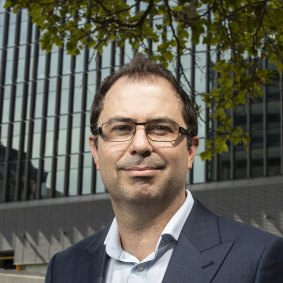This was published 9 months ago
Opinion
How crazy house prices and an ageing population are creating ‘tombstone suburbs’
Matt Wade
Senior economics writerThere’s something strange going on in the best-located suburbs of our biggest cities. As the national population surges, they are shrinking.
In Melbourne’s affluent east and bayside areas, a swath of suburbs had population declines between 2019 and 2023, even though the city as a whole grew by 4 per cent in that period. It was a similar story in Sydney, where the headcount shrank in districts across the eastern suburbs, lower north shore and inner west.

Illustration: Simon LetchCredit:
Inner Sydney and inner Melbourne also have a growing number of “tombstone suburbs”, where deaths consistently outnumber births. In Hunters Hill, a waterfront neighbourhood on Sydney’s lower north shore, there were 113 more deaths than births in 2022-23, while in Melbourne’s well-heeled Camberwell, deaths outnumbered births by 78 that year.
Meanwhile, outer suburbs have been adding people at breakneck speed. The population of Rouse Hill-McGraths Hill in north-western Sydney surged 52 per cent between 2019 and 2023. In the Melton-Bacchus Marsh region in Melbourne’s west, the population jumped 22 per cent over that period.
These trends are warping Australia’s two biggest cities, as outer suburbs are forced to accommodate a disproportionate share of a growing population.

Terry Rawnsley is an urban planner with KPMG. Credit:
Analysis by leading urban economist Terry Rawnsley shows the inner urban population slump has been driven by the loss of prime-age workers aged between 20 and 64 years. As thousands of inner-city homes designed for families remain underutilised, a legion of young families has little choice but settle in greenfield areas where local employment opportunities are limited and long commutes the norm.
“Despite being areas with exceptional access to jobs and excellent local infrastructure, inner-city suburbs of Melbourne and Sydney are seeing a decline in population simply because young people can’t afford to live there,” says Rawnsley, a consultant with KPMG.
While inner suburbs of Melbourne and Sydney are losing young people, working-age populations in comparable areas of Brisbane and Perth grew strongly between 2019 and 2023.
Yawning differences in the age profiles of inner suburbs and outer suburbs help illustrate what is happening in Melbourne and Sydney. The median age in Melbourne’s bayside suburb of Brighton (48 years) is 17 years older than in Craigieburn in the city’s outer north (31). In Sydney’s harbourside Double Bay-Darling Point, one in every four locals is aged over 65, while at Oran Park in the city’s outer south-west the share is just one in 20.
As more workers are forced to locate long distances from downtown job hubs, the strain on transport and local infrastructure intensifies. Expensive new rail and road projects are needed to move people across the urban sprawl. Adding new homes in established urban areas is also much cheaper than on the outskirts.
The misallocation of resources is sapping productivity citywide and threatens to make Sydney and Melbourne harder places to do business. The exodus of 20-64 year olds also threatens to hit local inner-city economies as the pool of young workers shrinks.
Rawnsley says a 2.5 per cent drop in working-age population – as happened in the eastern suburbs of both big cities between 2019 and 2023 – could feel like a local recession. “We’ve seen what happens in country towns when you get an ageing and shrinking population – businesses like shops and restaurants often have limited hours because they can’t get enough staff. That sleepy coastal town syndrome could easily be imported to some inner suburbs of Melbourne and Sydney.”
This demographic challenge is exacerbated by plunging birth rates. In Melbourne’s inner east, the fertility rate (the expected number of births per woman) has slumped to just 1.1 – half the 2.1 ‘replacement level’ needed to maintain a stable population, not including migration. Sydney’s inner west is similar, with a fertility rate of 1.3.
The high cost of housing in well-located suburbs is perhaps the biggest factor distorting population growth patterns in Sydney and Melbourne. This is exacerbated by a chronic shortage of supply in these areas. Rawnsley warns housing affordability is now reshaping the urban fabric of Sydney and Melbourne “at a remarkable speed”.
While governments are attempting to lift the housing supply, including the diversity of dwelling-types, it will take many years – perhaps decades – in well-located suburbs.
But a knot of demographic trends is also helping to warp our cities, especially the ageing of the population. Improved life spans means people are occupying well-located homes for longer.
“When life expectancy was shorter, say in the mid-70s, housing in the eastern suburbs of Melbourne and Sydney turned over more quickly,” says Rawnsley. “Now, with life expectancy heading towards 90, housing turnover is taking longer, so we are not used to dealing with how it plays out in the housing market. This is a new problem for us to grapple with.”
Behaviour has also changed. In the past, many retirees permanently left big cities for a sea change or tree change, but more are now staying put near the cultural attractions and high-quality healthcare offered by big cities.
Recent patterns of wealth distribution, underpinned by strong growth in property prices, means many more middle-aged and older people have the money to live at the beach, or in the country, while keeping a crash pad in inner Melbourne or Sydney. This also contributes to the under utilisation of housing in our best-serviced suburbs.
These demographic trends are deep-rooted and will affect Melbourne and Sydney for decades to come.
Matt Wade is a senior economics writer at The Sydney Morning Herald.